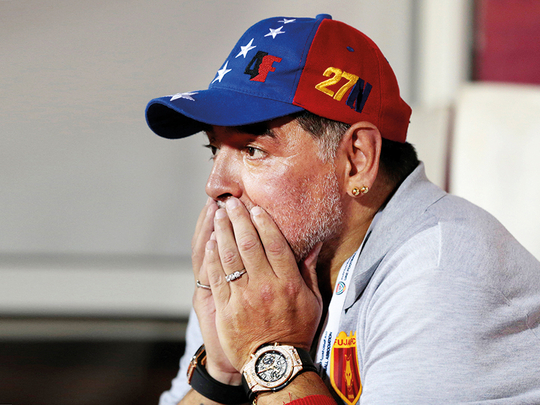Dubai: Diego Maradona always loved springing a surprise on the rival defence on his way to opening up the goalmouth. It could often be with a sleight of the left foot as the whole of England midfield and defence will testify after their 1986 World Cup quarter final, or the canny final passes which he unleashed four years later in Italia ‘90 with a below par Argentina team and nearly took them to the doorstep of what could have been back-to-back Cup triumphs for him.
The least of the surprises, which legion of his fans who have grown with him, however expected was the shocking news of his demise on what was an otherwise slow night in the world of sport. Yes, he was released from the hospital after a brain surgery a few days back, there were reports of him suffering from depression as well – but one thought they were just ‘one of those things’ which he had taken in his stride over the last two decades.
Didn’t he always live life dangerously? It was way back in 2000 – barely five years after quitting the game when he nearly died of a cocaine-induced heart failure – only to re-invent himself in a stunning comeback in 2008 as coach of the Argentina. Under his guidance, Lionel Messi & Co made the quarter finals of the World Cup in South Africa two years later, but Maradona could never actually convince the football world that he had it in him as a tactically astute coach.
READ MORE
A genius with a tragic flaw, the maverick or the ‘greatest’ debate between him and Pele – trending topics like this have tried to capture the legacy of the man ever since he quit the game. The biggest undoing for him was – and that could have perhaps left him a somewhat disillusioned man in his later years – was that he could not keep himself relevant in the way a Pele or Franz Beckenbauer could organise their profile in their post-football years.
Born on October 30, 1960 in the Buenos Aires working class suburb of Lanus, the fifth of eight children of a factory worker, Maradona grew up in the Villa Fiorito shanty town.
At 17 years, he just missed inclusion in Argentina’s 1978 World Cup-winning squad at home. In the 1982 tournament in Spain, a sending-off against Brazil was a fitting prologue to two unhappy seasons at Barcelona, marred by hepatitis and injury.
The turning point came in 1984, when he moved to Napoli for a then world-record $7.5 million contract and helped the underdogs win the Scudetto twice – which prepared the foundation for him to rule the ‘86 World Cup.
Come the early ‘90s, drugs and alcohol gradually began taking over his life. He was banned for 15 months after testing positive for drugs at the 1994 World Cup in the United States – signalling the end of an incredible career.
It had been a story of terminal decline for him there onwards, with him making headlines for the wrong reasons – often surrounding himself with an entourage of yes-men and became known for his sharp-tongued confrontations with reporters and critics. It’s not that he didn’t make an effort to come back to the mainstream by taking up coaching assignments or amabassador roles in different parts of the world – but nothing matched the pinnacle of glory he reach as a footballer.
“Soccer is the most beautiful and healthy sport in the world. Soccer shouldn’t have to pay for my mistakes. It’s not the ball’s fault,” Maradona had once famously said.
Was there a tinge of regret in those words? We will never knew.
RIP, Diego Maradona!


